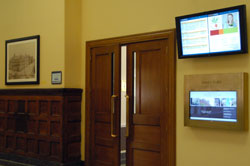Filed Under > TC Community
On the Anniversary of the Americans with Disabilities Act, a New System for Navigating TC's Campus
As the nation celebrates the 24th anniversary of the Americans with Disabilities Act, TC is launching a unique new direction-finding system that will help blind and visually impaired users and people who use wheelchairs better navigate the College’s often labyrinthine hallways and surrounding streets.
The new system, which is now fully operative, provides an accessible alternative to the touch-screen kiosks in the lobbies of Zankel and Thorndike Halls that were part of a previous Columbia-wide installation. The kiosks are ubiquitous on college campuses, at airports and in other public sites in the United States and abroad, yet do not provide a voice narrative for blind users. The touch-screens are also too high for users in wheelchairs to reach them.
“Teachers College has historically served as a leader in meeting the needs of all its community members, as well as those of all learners,” said Richard Keller, Director of Services for Students with Disabilities. “Making our campus and surrounding environs fully navigable for all users is a natural extension of that commitment. We are proud to lead the way in undertaking this work.”
“What Teachers College has done with this new way finding project is create the very first accessible alternative to an inaccessible visual kiosk system,” said Joe Cioffi, founder and CEO of ClickAndGo Wayfinding Maps, which developed the new system for the College. “No one has ever done this before, anywhere.”
Through the new system, the kiosk data is translated into electronically generated voice instructions. Directions are accessible at no charge via telephone (877-604-4631; a website, which provides access to text, MP3 download, braille and large print; and an iPhone app.
“Essentially, we’ve made the database of the kiosks available at a single click to non-sighted users,” Cioffi says. “The system provides directions from any security point to all important offices and indoor locations, and then back to the original transit point. It really covers everything of importance in the TC world.”
Users are given a starting landmark followed by a series of steps, with precise distances, to a desired location. For example, someone traveling from the College’s main entrance in Zankel Hall to the Office of External Affairs in 186 Grace Dodge Hall would receive the following instructions:
There are 7 directional steps to go from "Zankel Security Entrance" to "Office of External Affairs".
- Facing the Zankel security desk, turn right and walk 10 feet to ascending stairs. Ascend to an intersecting stone floored hallway.
- Turn right. Walk ahead 40 feet to the first intersecting hallway on the left. Turn left. Continue 90 feet to a wooden push door.
- Enter, and walk through a 15-foot enclosed foyer to a second wooden pull door. Enter onto a wooden floor. The hallway narrows, and you are now in Grace Dodge. Turn right.
- Walk ahead 125 feet to closed fire doors. Pass through these doors, and be aware there is an intersecting hallway and descending stairs to the right.
- Stay straight in this narrow hallway to a door 10 feet ahead. To reach this door, you must use either a narrow ascending ramp on the left or 2 ascending steps straight ahead.
- Ascend and walk a few feet ahead to a pull door. Enter and continue in this narrow hallway. The flooring changes from wood to tile.
- Ahead in 50 feet, the 3rd door on the left, is the office for Development and External Affairs, Room 197.
The directions, regardless of the format they are received in, can be paused and replayed ad infinitum, so that the user can hear them while in transit.
“Most people who are legally blind have some sight,” explains Cioffi, a longtime consultant in deaf/blind education whose past credits include supervising the Orientation & Mobility department at the Helen Keller National Center and directing the first master’s-level program for O & M instructors in Thailand. “We want to provide them with a cognitive map to go with directions, just the way Google does.”
The second phase of the project, which will launch in 2015, features a number of improvements, including the incorporation of low-vision maps and the use of beacon technology. The latter is a first-of-its-kind form of real-time location support that announces when users are approaching landmarks along their routes. The landmarks might be points of interest, frequently used resources (such as the Office of Disabilities) or potential hazards, such as staircases.
“TC is not the simplest place to navigate, whether you have sight or not,” says Keller. “The beauty of all these improvements is that once in a while you can do something that helps everybody, people with and without disabilities. We hope this state of the art way finding system can help people who are blind, use wheelchairs or simply not familiar with the TC campus or just plain lost.”
Published Thursday, Jul. 24, 2014
